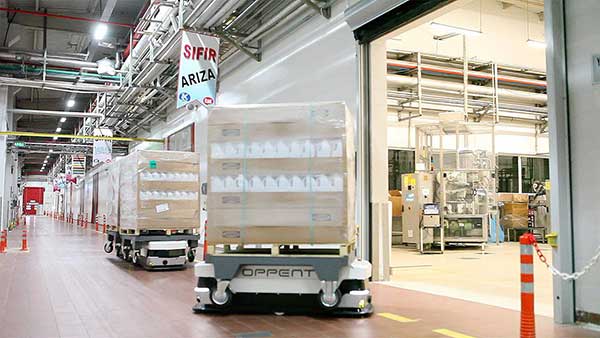Electrification is opening up opportunities in material handling with the electrification of traditional equipment and fresh innovation.

by Mirko Baggio, Director of Business Development, ZAPI GROUP
Electrification has a long history in the material handling space, with the first innovations dating back to the 19th century. Companies rolled out designs for early, rudimentary electric vehicles during that period. One of the first contributors to early electric innovation was the Rauch and Lang Carriage Company out of Cleveland, Ohio. After the introduction of the internal combustion engine (ICE) in 1876 squelched early progress toward consumer EVs, Rauch and Lang pivoted their business focus to stay relevant. Their attention shifted to the material handling industry. One of their earliest contributions to material handling was the invention of the first electric ram truck for carrying steel coils. In 1977, Linde Material Handling purchased the company and became the inventor of the first electric forklift. Countless product rollouts have come since those early days, and the runway for more innovation continues to surpass what previous generations thought possible.
Material handling covers many definitions. Regarding electrification, material handling is the movement of goods and components throughout the supply chain using electric-powered equipment and technology. These movements can be small, within the aisles of a single warehouse, or large, transporting products across long distances. Electric-focused machinery is challenging its ICE counterparts on multiple playing fields. The 1971 electric forklift, while impressive for its time, has come a long way over subsequent decades. The modernization of the forklift throughout the decades is significant because lift trucks continue to be an integral part of nearly every supply chain, regardless of the materials that organizations are handling.
Mobile robotics is another exciting category in electric material handling. Robotics is not new, but the mobile robotics category has seen significant growth in the past few years. Projections for 2023 put the market at $54.1 billion, up from just $18.7 in 2018. Robots can be used in various applications, from pick-and-pack to component manipulation on a production line. Robotics, in conjunction with autonomous navigation technology, can give manufacturers real-time views and data on the entire material handling process on their floors.
Swiss company BlueBotics is a pioneer in the autonomous navigation space. BlueBotics specializes in a highly accurate and robust form of this technology called ANT natural feature navigation.
Vehicles driven by ANT technology use the robot’s built-in safety lasers to scan surroundings to first “identify and then match permanent features in the environment, such as walls, pillars, and machines.” Once the technology completes the navigational scan, these vehicles can navigate warehouse and manufacturing floors and perform various tasks (e.g., pick and pack, component movement down the production line, etc.) with minimal infrastructure changes required.
Previously performed manually, automating these tasks leads to a reduction in errors and increased efficiency, thus allowing employees to focus on higher-value work.
Running parallel to the technological advances are several other external factors that promote the push toward widespread electrification. Global climate change action is one of the most significant. The U.S. Inflation Reduction Act (IRA) includes billions set aside for electric investments and incentives. Manufacturers considering electrification of their equipment fleets are now financially incentivized to take that leap. Alongside potential tax credits, OEMs investing in material handling equipment will be in line with a positive growth forecast.
Another major driver in electrifying material handling is the increase in e-commerce traffic. Industrial companies are keenly aware of this trend, with 70% of companies on schedule to implement a B2B eCommerce solution by 2023, up from 50% at present. One of the many takeaways from the pandemic was that labor shortages could come swiftly and have dire consequences on supply chains. Electric fleets can integrate easily into workflows and be managed remotely with minimal onsite visits allowing the continuation of movement of essential materials.
The current economic climate and workforce trends also impact commercial real estate market trends in the material handling space. Estimates show growth of warehouse operations spaces is trending up while other categories, such as office spaces, are trending down. This reflects the paradigm shift by many companies to work-from-home models, combined with an increase in consumer online buying habits.
On the industrial-focus side, OEMs also influence the growth of electrification in material handling. This movement was a key takeaway from this year’s Industrial & Off-Highway Vehicle Technology Expo (iVT) in Chicago, IL. The material handling equipment (MHE) industry, which is about 65% electrified, is looking at electrifying Class 4 and 5 internal combustion engine (ICE) equipment. Component innovation is a key contributor to those electrification conversions with the availability of longer-lasting batteries, higher power chargers and more advanced motors.
All signs indicate more electric innovation in material handling across all industries. Electric innovation is growing out of necessity to maintain the demands of global supply chains. OEM investments in electrification initiatives, whether in supplier partnerships or dedicated innovation teams, all add up to a smart and sustainable roadmap to success.
About the Author:
Mirko Baggio is the Director of Business Development at ZAPI GROUP. Mirko joined ZAPI GROUP in 2006 and has nearly 15 years of experience in the electric drive industry. Throughout his time with ZAPI, he has managed accounts, informed global growth strategies and spearheaded product and customer opportunities in new markets. Prior to his role as Director of Business Development, Mirko was the Director of Sales & Marketing with ZAPI Shanghai.
Scott Ellyson, CEO of East West Manufacturing, brings decades of global manufacturing and supply chain leadership to the conversation. In this episode, he shares practical insights on scaling operations, navigating complexity, and building resilient manufacturing networks in an increasingly connected world.